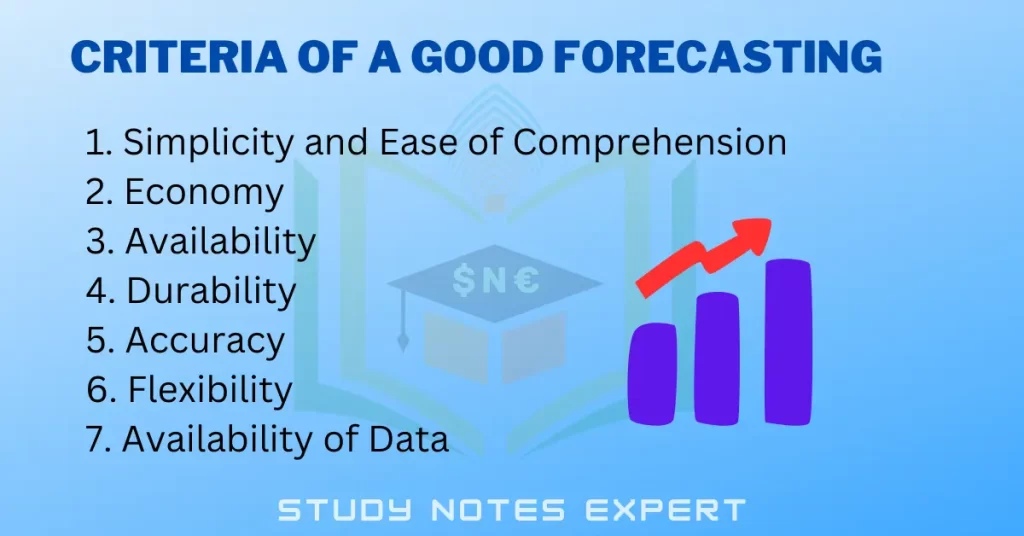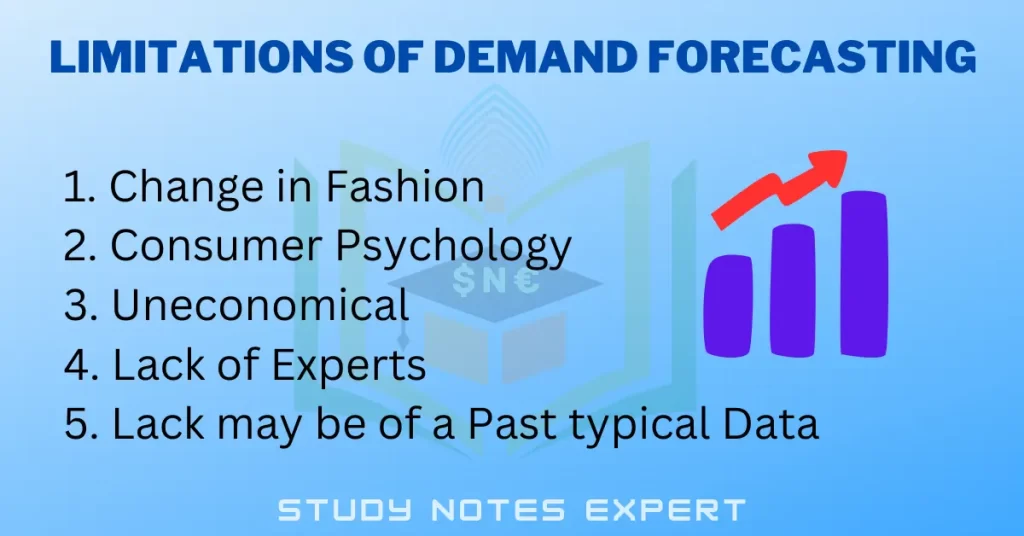Forecasting is a technique that facilitates the process of planning and enabling efficient decision-making. By this estimates, projections are made for the future. Combining the aspect of forecasting with demand, it serves with the future projections regarding the quantity demanded in precise. Certain questions like which product will be in demand? What will be the quantity demanded? Where will be the demand? are answered by demand forecasting. It also helps in developing relation between the demand and price along with the price of the substitutes that are available. The change in demand as a result of change in any of these factors is also revealed.
According to American Marketing Association, “Demand forecasting is an estimate of sales in rupees or physical units for a specified future period under a proposed marketing plan”.
Criteria of a Good Forecasting – 7 Points

1. Simplicity and Ease of Comprehension
Management must be able to understand and have confidence in the techniques used. Complicated mathematical and statistical techniques may be avoided.
2. Economy
Cost must be weighed against the importance of the forecast to the operations of the business. The criticism should be the economic consideration of balancing the benefits from increased accuracy against the extra cost of providing the improved forecasting.
3. Availability
Techniques should give quick results and useful information.
4. Durability
Durability of the estimating power of a demand function depends on reasonableness and simplicity of functions fitted.
5. Accuracy
Sales forecasting is the basis of marketing planning and, therefore, sales forecasts should be as much accurate as possible.
6. Flexibility
Another attribute of a good forecasting method is its flexibility. It means we should be able to accommodate some changes in the variables which determine the demand. If the model for demand forecasting is very rigid, then its predictive power is considerably reduced.
7. Availability of Data
Any forecasting is based on the availability of data, which is fitted in a model to estimate future demand. If the data, whether primary or secondary, is easily available, then only it can be used. If the data requirement is clumsy or unavailable, then obviously the forecasting method is of little use. Need for Demand Forecasting
Need of Short-Term Forecasting
1. Appropriate Production Scheduling
Appropriate production scheduling so as to avoid the problem of over-production and the problem of short supply. For this purpose, production schedules have to be geared to expected sales.
2. Helping the Firm in Reducing Costs
It helps the firm in reducing costs of raw materials and controlling inventory by determining its future resource requirements.
3. Determining Appropriate Price Policy
Determining appropriate price policy so as to avoid an increase when the market conditions are expected to be weak and a reduction when the market is going to be strong.
4. Setting Sales Targets and Establishing Controls and Incentives
If targets are set too high, they will be discouraging salesmen who fail to achieve them; if set too low, the targets will be achieved easily and hence incentives will prove meaningless.
5. Forecasting Short-Term Financial Requirements
Cash requirements depend on sales level and production operations. Moreover, it takes time to arrange for funds on reasonable terms. Sales forecasts will, therefore, enable arrangement of sufficient funds on reasonable terms well in advance.
Need of Long-Term Forecasting
1. Planning of a New Unit or Expansion of an Existing Unit
It requires an analysis of the long-term demand potential of the products in question. A multi-product firm must ascertain not only the total demand situation, but also the demand for different items separately. If a company has better knowledge than its rivals of the growth trends of the aggregate demand and of the distribution of the demand over various products, its competitive position would be much better.
2. Planning Long-Term Financial Requirements
As planning for raising funds requires considerable advance notice, long-term sales forecasts are quite essential to assess long-term financial requirements.
3. Planning Manpower Requirements
Training and personnel development are long-term propositions, taking considerable time to complete. They can be started well in advance only on the basis of estimates of manpower requirements assessed according to long-term sales forecasts.
Top 5 Limitations of Demand Forecasting

1. Change in Fashion
Change in fashion is an inevitable consequence of advancement of civilisation. Results of demand forecasting have short lasting impacts especially in a dynamic business environment.
2. Consumer’s Psychology
Results of forecasting depend largely on psychology of consumers, understanding which itself is difficult. Thus, demand forecasting becomes an uphill task.
3. Uneconomical
Forecasting requires collection of data in huge volumes and their analysis, which may be too expensive for small firms to afford. Moreover, estimation process may take a lot of time, which may not always be affordable by firms.
4. Lack of Experts
Accurate forecasting necessitates experienced experts, who may not be easily available. Forecasting by less experienced individuals may lead to erroneous estimates.
5. Lack may be of a Past typical Data
Problem Demand in case forecasting of forecasting requires for past a new sales product. Data which may not be easily available. This maybe a typical problem in case of forecasting for a new product.
What is the Main Purpose of Demand Forecasting?
Demand forecasting is a quantitative aspect of demand planning. Its goal is to estimate future customer demand to help create a production plan that ensures the correct inventory level.
What is a Good Forecasting Method?
A suitable forecasting method is the one that best suits the data and the purpose of the forecast. There are many best forecasting methods. Some standard methods are regression, time series analysis, and exponential smoothing. The best method to use depends on the data available and the nature of the phenomenon being forecast.
What are the 5 Key Reasons to Forecast?
The five key reasons to forecast are:
1. To estimate future demand for a product or service 2. To plan production or capacity levels 3. To plan inventory levels 4. To assess the likely financial performance of a company 5. To inform marketing and sales planning

